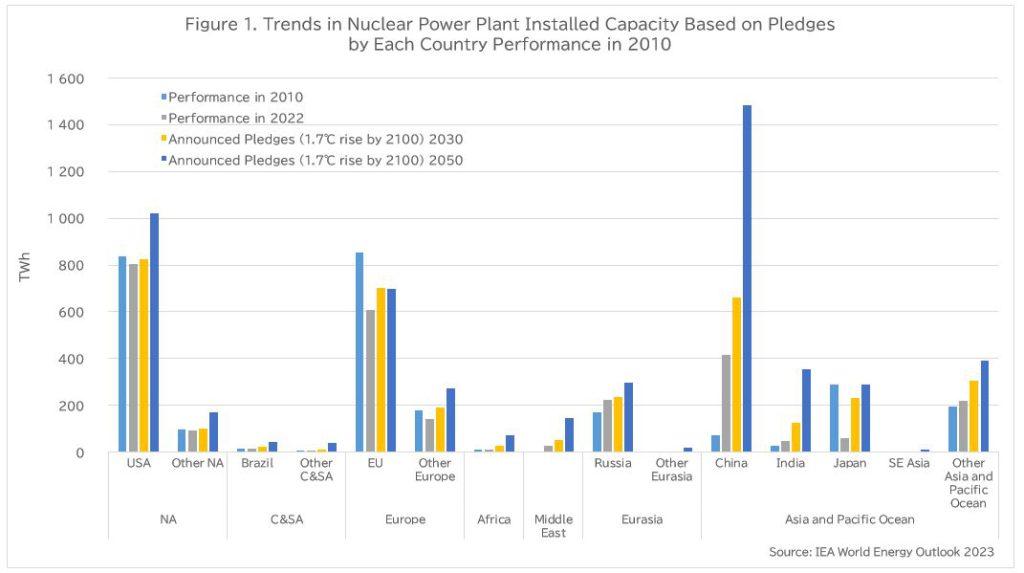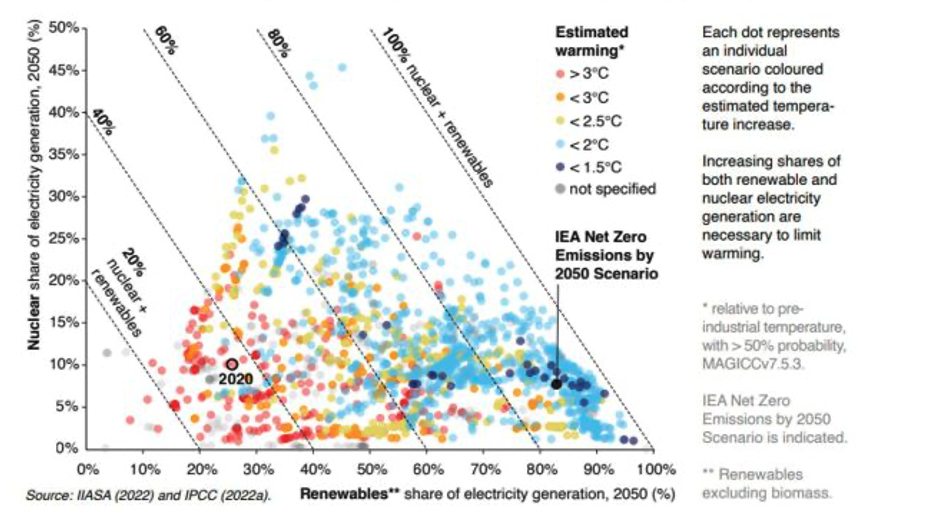CNIC Statement: Nuclear Industry Dancing in Other People’s Shoes Regarding the Pledge to Triple NPPs
December 5, 2023
At COP28 in Dubai, the United States and the United Kingdom led a pledge to triple the world’s nuclear capacity by 2050 [i]. The 22 participating countries are the United States, Bulgaria, Canada, Czech Republic, Finland, France, Ghana, Hungary, Japan, South Korea, Moldova, Mongolia, Morocco, the Netherlands, Poland, Romania, Slovakia, Slovenia, Sweden, Ukraine, United Arab Emirates and the United Kingdom.
According to the Announced Pledge Scenario (APS, national commitment scenarios that will lead to a 1.7°C temperature rise in 2100) published in the World Energy Outlook 2023 released by the International Energy Agency this October, the Middle East and Africa are the only areas where nuclear power generation capacity will more than triple. These are also miniscule in overall terms, with substantial growth expected in China and India (Figure 1) [ii]. This pledge refers to installed capacity, which is not exactly equal to the amount of electricity generated, but is generally proportional to it. Many of the countries signing on to the pledge, including Japan, have said they will triple the number of nuclear power plants (NPPs) in the world despite being none too keen to increase the number of NPPs in their own countries. This is an utterly astounding declaration.
Incidentally, the pledge will encourage the World Bank and other financial institutions that do not currently finance projects related to NPPs to do so in order to create an environment for tripling NPP installed capacity. What countries are now considering the introduction of nuclear power?
At the World Nuclear Exhibition held in Paris on November 28, prior to COP28, IAEA Director General Grossi stated that within the next few years 12 or 13 countries would join the list of new nuclear powers, with Ghana, Kenya, Morocco, Nigeria, Namibia, the Philippines, Kazakhstan and Uzbekistan being among the candidates [iii].
Figure 2 shows national expenditures and costs of introducing NPPs in recent years for the candidate countries named by the IAEA and the countries participating in the declaration that have not yet introduced nuclear power. It can be seen that the cost of installing NPPs exceeds national expenditure in most of the countries. Even the cost of the NuScale project, a small modular reactor that is considered relatively inexpensive to install, is close to $10 billion. Moreover, when considering power ratio, the cost of this project does not even come close to that of other large light water reactors (LWRs).

Of these candidate countries, Ghana defaulted on its debt in 2022. According to the IMF, 26 of the world’s 70 low-income countries, including Kenya, are considered to be at high risk of becoming overindebted [iv]. In other countries, spending on projects that match or exceed the size of national expenditures will, of course, create fiscal constraints.
Because of the inherent danger of nuclear power, it is necessary for the countries where NPPs are introduced to be socially and economically stable. However, if the government attempts to introduce nuclear power into a country with a modest fiscal base, it will result in a huge debt burden. There are countless examples of how excessive debt has destabilized nations.
The initial investment in NPPs is so high that there is little room to increase NPPs within the home country. These countries therefore want to export NPPs to countries with smaller financial bases. In doing so, the World Bank and others will be pressured to lend at relatively low interest rates. This is the intention of this pledge.
Figure 3 shows an IAEA analysis of the percentages of nuclear power and renewable energy in the power generation mix based on an IPCC scenario [v]. It can be seen that there are broadly three scenario patterns in which the 1.5°C target can be achieved. That is, (1) about 80 to 100% of renewable energy and about 0 to 10% of nuclear energy, (2) about 60 to 70% of renewable energy and about 10% of nuclear energy, and (3) about 35 to 45% of renewable energy and about 25 to 30% of nuclear energy. As the IAEA itself recognizes, increasing the percentage of nuclear power will reduce the percentage of renewable energy. The IAEA recommends the operation of NPPs using nuclear power output adjustment [vi]. What is theoretically and technically possible is one thing, however, and what is economically possible is quite another. NPPs require very high initial investment and have low fuel costs. Nuclear power is a power source for which the high initial investment can only be recovered after a considerable number of years of stable operation. Thus, it is not profitable to operate NPPs with frequent power output adjustments. However, in a world where the proportion of renewable energy in the energy mix has increased it will be necessary to carry out exactly that—frequent output adjustments. Nuclear power and renewable energy are therefore not well-matched power sources. The higher the proportion of renewable energy, the more dots there are on Fig. 3 indicating the 1.5°C or 2°C scenario. Thus, as nuclear power and renewable energy do not sit well together, increasing the number of NPPs is a risky solution to the climate crisis.
Figure 3: Shares of nuclear and renewable energy in the electricity generation mix and corresponding climate warming across IPCC AR6 scenarios.
Source: www.iaea.org/sites/default/files/iaea-ccnp2022-body-web.pdf
In addition to the declaration tripling NPPs, 118 countries at COP28, led by the EU, pledged to triple the installed capacity of renewable energy and double the rate of energy efficiency improvement from the current 2% to an annual figure of 4% [vii]. The target year is 2030. An NPP is a power source that can take 20 years or even longer from planning to operation. That’s not terribly useful for decarbonization that is required right away. As evidenced by the fact that the declaration tripling NPPs sets a target year of 2050, NPPs will delay decarbonization.
According to the World Energy Outlook 2023, China and India, which did not participate in the pledge, had installed nuclear power capacities of 418TWh and 50TWh, respectively, in 2022 and are expected to more than triple these to 1,483TWh and 355TWh, respectively, under the APS scenario. But that’s another big question. The number of NPPs in China is said to be increasing rapidly, but the rate of increase is falling. India has many construction projects, but most have been delayed or have not even begun.
It can be said that this pledge is extremely irresponsible and unethical. This constitutes an attempt, in the name of combating climate change, on the part of some countries to sell NPPs, which are expensive, take years to install, and do nothing to combat climate change, to relatively weak countries in order to aid the survival of their own nuclear industries. Moreover, many of the countries that have signed on to the pledge have little room to implement nuclear power increases in their own countries, including Japan. Countries that will triple their number of NPPs are countries that did not participate in the pledge. The image is one of someone ‘dancing in other people’s shoes’ and bringing this image to realization is simply an impossibility.
[i] www.energy.gov/articles/cop28-countries-launch-declaration-triple-nuclear-energy-capacity-2050-recognizing-key
[ii] www.iea.org/reports/world-energy-outlook-2023
[iii] www.reuters.com/business/energy/iaea-says-dozen-countries-be-equipped-with-nuclear-power-2023-11-28/
[iv] www.imf.org/external/pubs/ft/dsa/dsalist.pdf
[v] www.iaea.org/sites/default/files/iaea-ccnp2022-body-web.pdf
[vi] www.iaea.org/publications/15098/nuclear-renewable-hybrid-energy-systems
[vii] ec.europa.eu/commission/presscorner/detail/en/ip_23_6053


